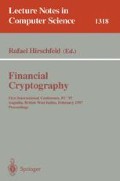Abstract
This paper describes an extension to the current Java security model called the “Gateway” and why it was necessary to create it. This model allows secure applications, such as those used in electronic commerce, to safely exchange data and interoperate without compromising each individual application's security. The Gateway uses digital signatures to enable application programming interfaces to authenticate their caller. JavaSoft is using the Gateway to create a new integrated open platform for financial applications called Java Electronic Commerce Framework. The JECF will be the foundation for electronic wallets, point of sale terminals, electronic merchant servers and other financial software. The Gateway model can also be used for access control in many multiple application environments that require trusted interaction between applications from multiple vendors. These applications include browsers, servers, operating systems, medical systems and smartcards.
Preview
Unable to display preview. Download preview PDF.
References
Agorics Inc. http://www.agorics.com/allkey.html, September 15 1996.
V. Bertis. Security and Protection of Data in the IBM System/38 in Proceedings of the 7th Symposium on Computer Architecture,. May 1980.
J. B. Dennis and E. C. Van Hom, Programming Semantics for Multiprogrammed Computations. Communications of the ACM 9(3), March 1966.
E. Gamma, R. Helm, R. Johnson, J. Vlissides, Design Patterns, Elements of Object-Oriented Software, Addison Wesley 1995.
J. Gosling, W. N. Joy, F. Yellin; The Java Programming Language Addison Wesley 1996.
A Goldberg, D Robson, The Smalltalk-80 Language, Addison Wesley 1983.
G. Hamilton, M. Powell, J. Mitchell Subcontract: A Flexible Base for Distributed Computing. Symposium on Operating Systems Principles
K.G. Hamilton, The Java Beans Specification, http://java.sun.com/.
http://java.sun.com/commerce.
MasterCard/Visa Secure Electronic Transaction Protocol Specification (S.E.T.), http://www.mastercard.com/ and http://www.visa.com/.
M. Mueller, The Java Security Model, http://java.sun.com/
Object Management Group, The Common Object Request Broker, http://www.omg.org/.
W. Wulf, E. Cohen, W. Corwin, A. Jones, R. Levin, C. Pierson, and F. Pollack. Hydra: The Kernel of a Multiprocessor Operating System, Communications of the ACM 17(6), June 1974.
Author information
Authors and Affiliations
Editor information
Rights and permissions
Copyright information
© 1997 Springer-Verlag Berlin Heidelberg
About this paper
Cite this paper
Goldstein, T. (1997). The gateway security model in the Java Electronic Commerce Framework. In: Hirschfeld, R. (eds) Financial Cryptography. FC 1997. Lecture Notes in Computer Science, vol 1318. Springer, Berlin, Heidelberg. https://doi.org/10.1007/3-540-63594-7_90
Download citation
DOI: https://doi.org/10.1007/3-540-63594-7_90
Published:
Publisher Name: Springer, Berlin, Heidelberg
Print ISBN: 978-3-540-63594-9
Online ISBN: 978-3-540-69607-0
eBook Packages: Springer Book Archive

